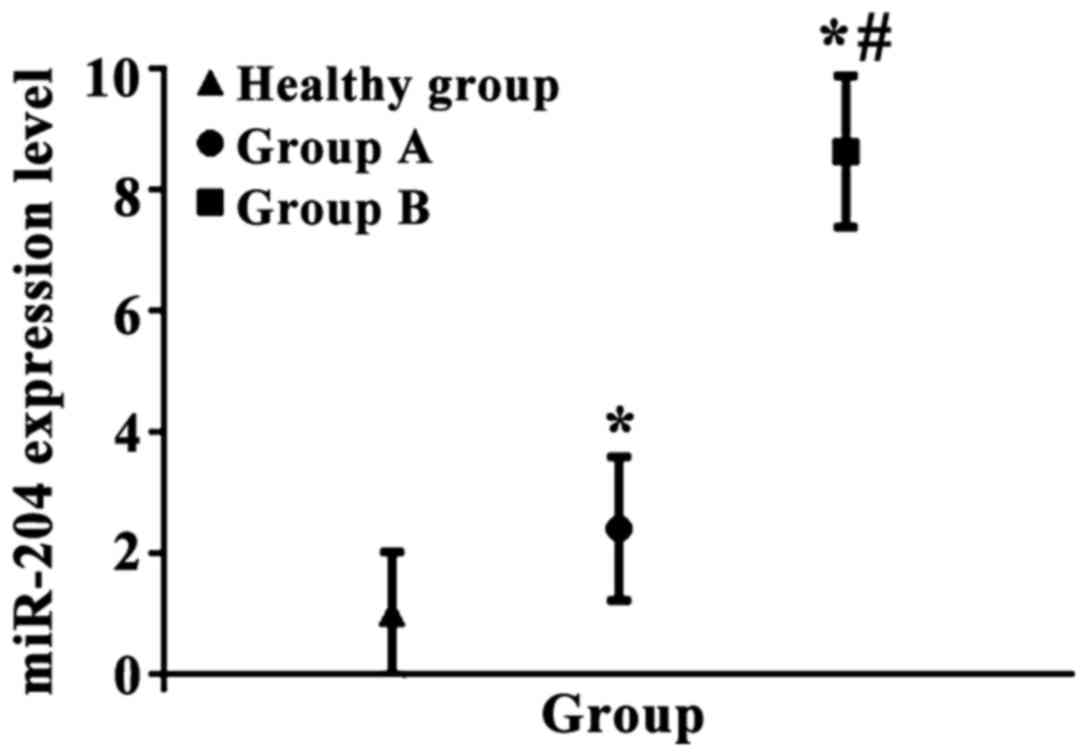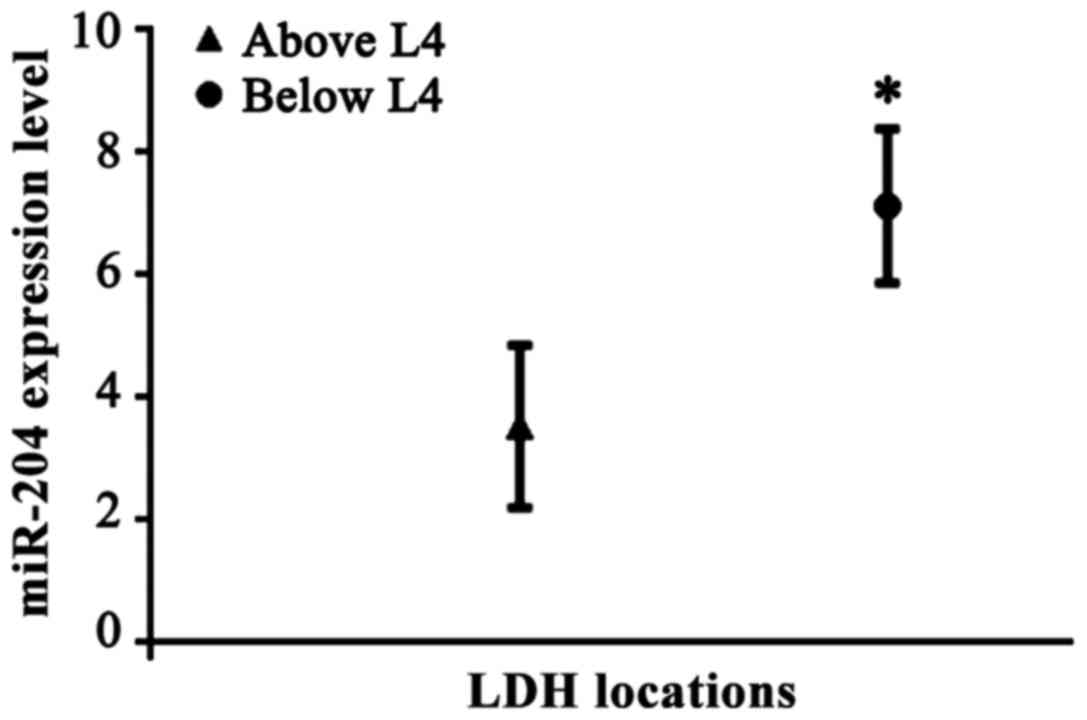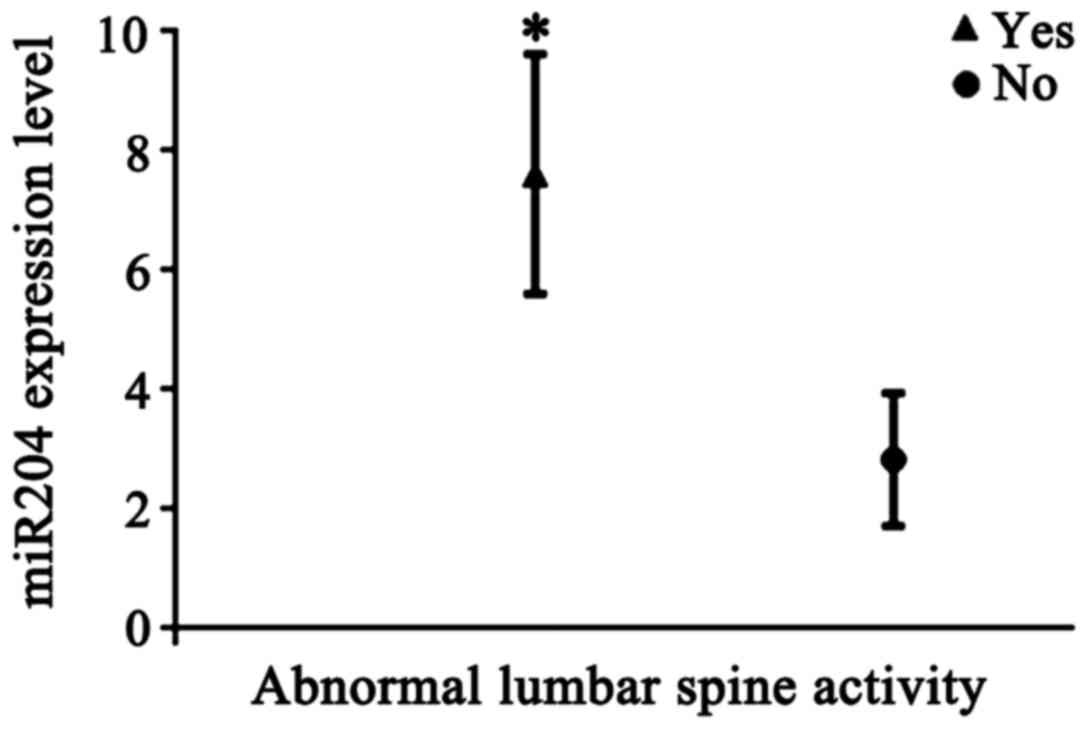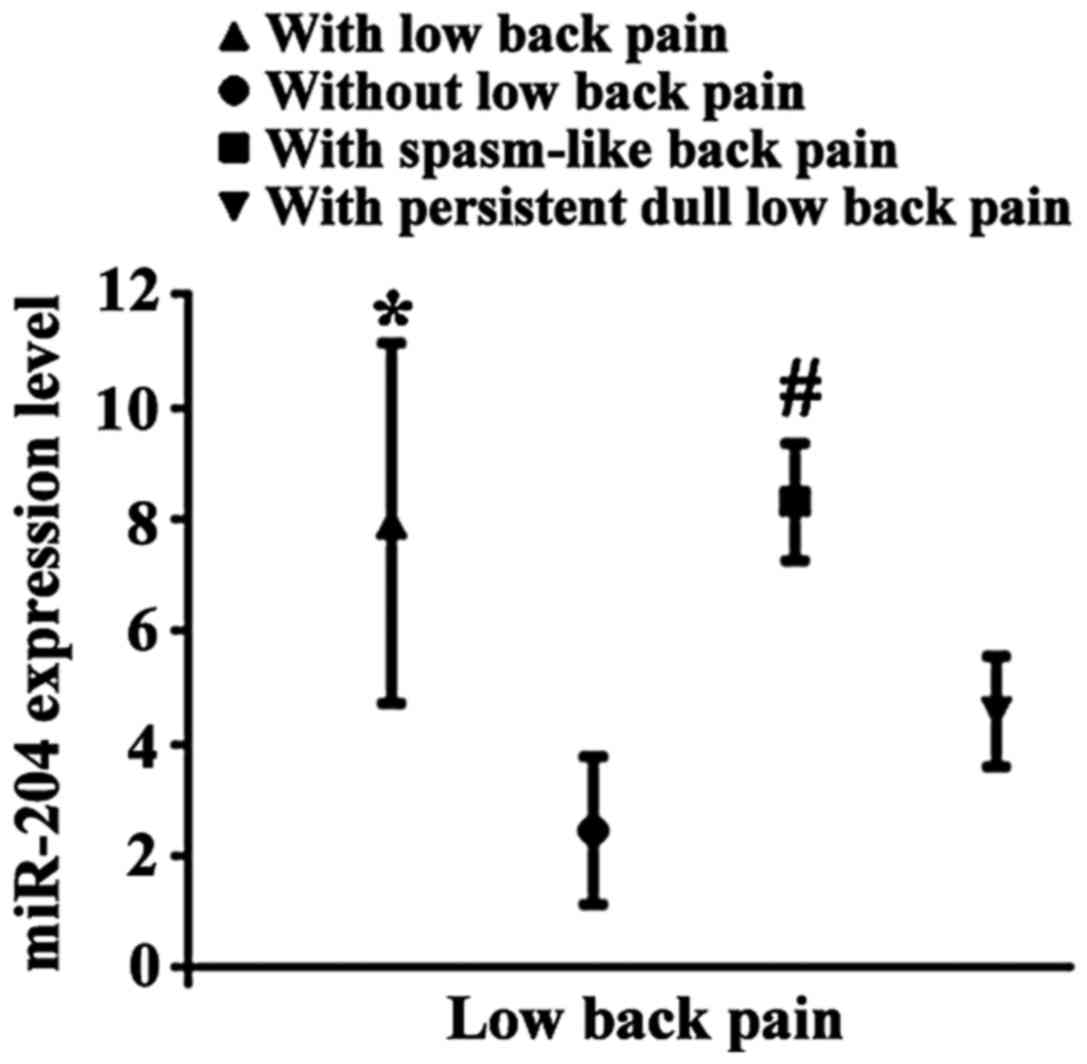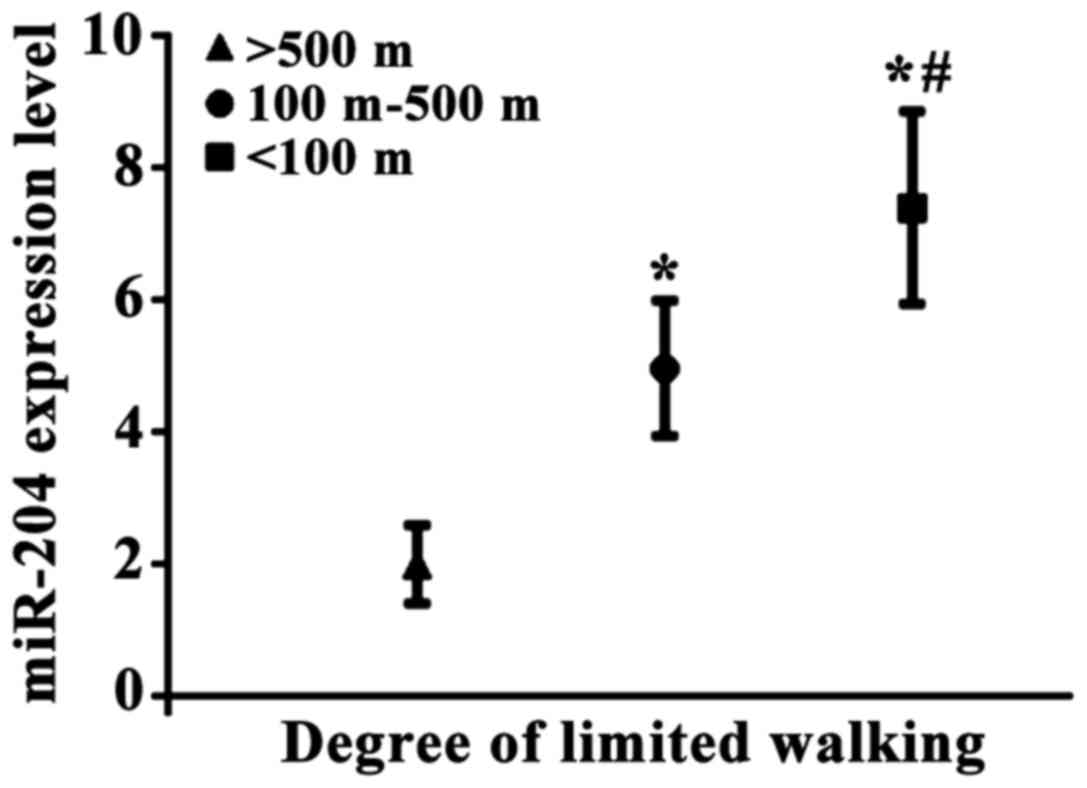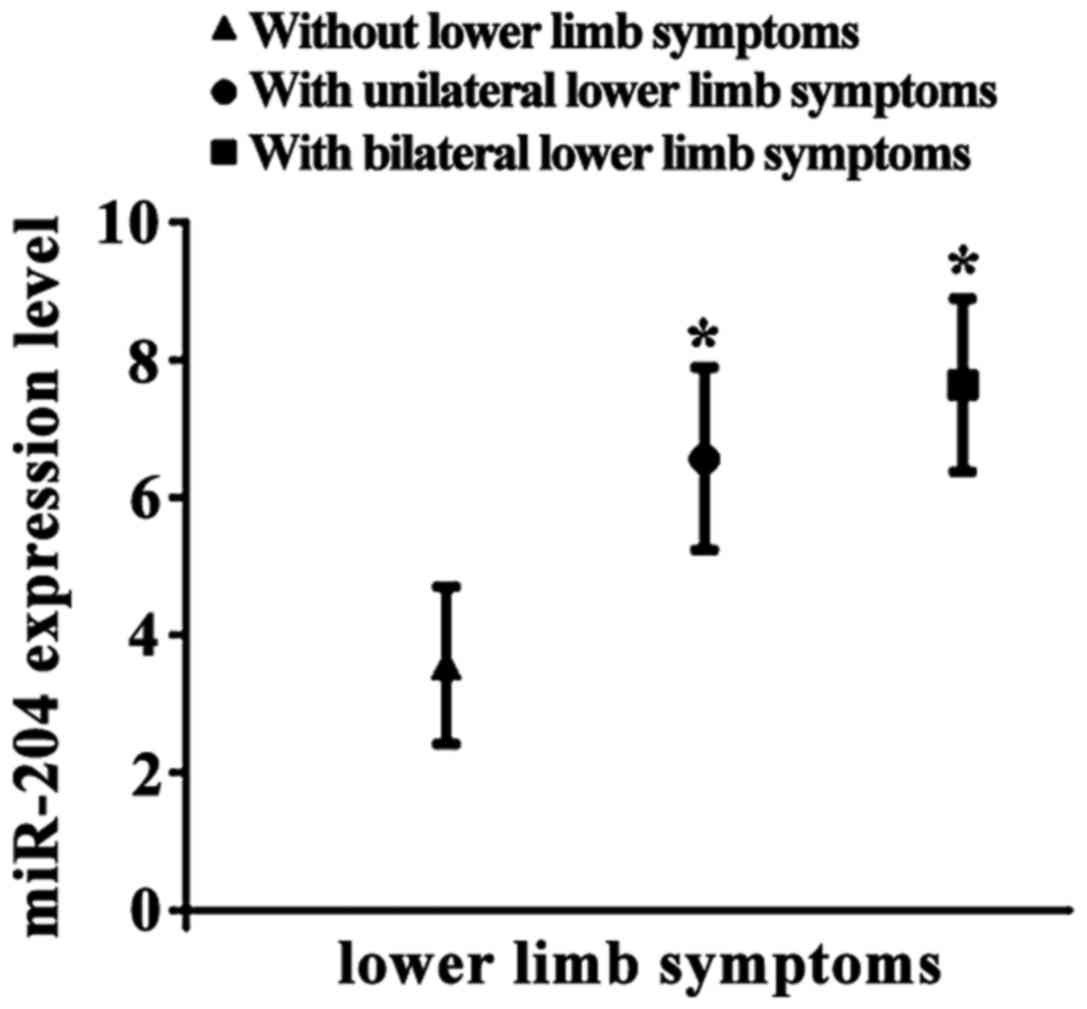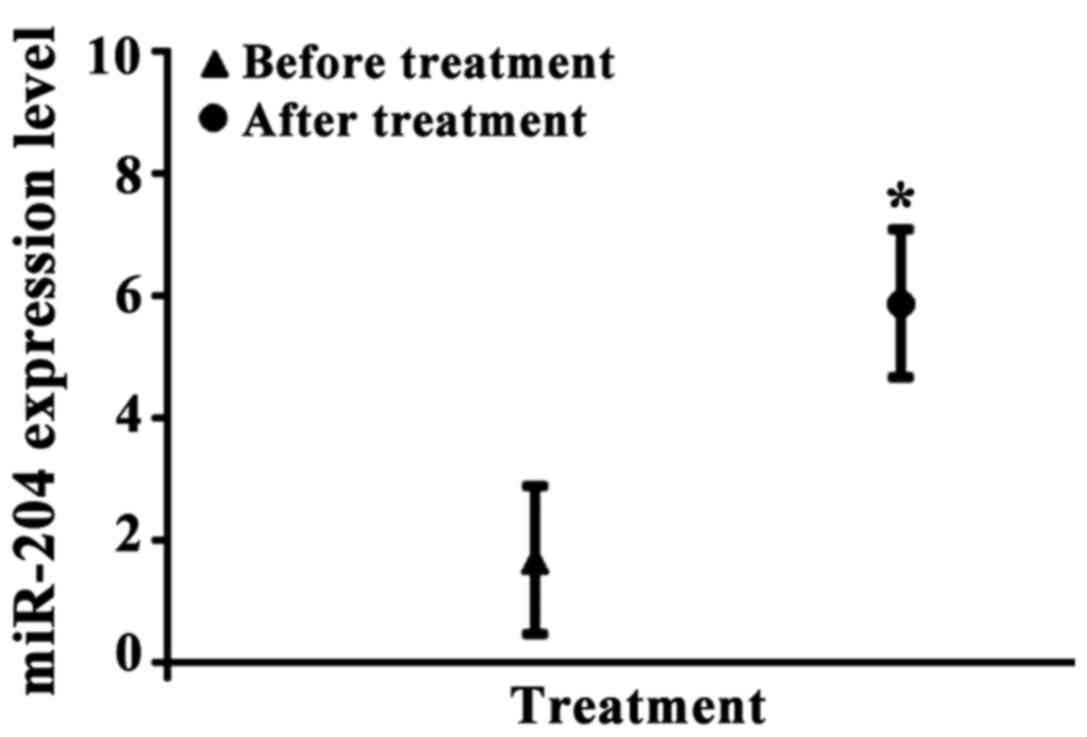Relationship between serum levels of miR-204 and clinical features of patients with lumbar disc herniation - an analysis based on 1,589 cases
- Authors:
- Published online on: June 27, 2018 https://doi.org/10.3892/etm.2018.6364
- Pages: 1679-1684
Abstract
Introduction
Lumbar disc herniation (1–3) (LDH) is usually caused by the intervertebral disc contents (nucleus pulposus) protruding through its outer membrane (fibrous rings). LDH usually occurs in posterolateral region. As one of the most common diseases, LDH mainly affects patients aged 40–50 years (mean age of 37 years). The incidence in males >35 years is 4.8% (4,5). LDH now has been recognized as a health problem world-wide (6). LDH is the most common diagnosis of lumbar degenerative abnormalities. Typical LDH includes initial low back pain and may eventually develop into persistent sciatica (7). LDH is characterized by the loss of proteoglycan and water content in the nucleus pulposus of the intervertebral disc. Although some genetic determinants have been reported, the etiology of LDH is largely unknown (8). miRNA-204 has differential expression in different types of tumors, and is closely correlated with proliferation, invasion and poor prognosis of tumors (9,10). However, the role of miRNA-204 in LDH is still unclear. In this study, expression of miR-204 in serum was detected by RT-PCR, and relationship between miR-204 expression and clinical features of patients with LDH was investigated.
Patients and methods
Clinical data
Clinical data of 1,589 LDH patients who were diagnosed in Shanghai Sixth People's Hospital East Affiliated to Shanghai University of Medicine and Health Sciences from January 2014 to January 2017 were retrospectively analyzed. Those patients included 869 males and 720 females. There were 953 patients (group A) with a duration of disease shorter than 3 months, and the other 636 patients (group B) were with a duration of disease longer than 3 months. The average age of the patients was 39.2±5.8 years. At the same time, a total of 300 healthy volunteers were also selected, and their average age was 35.6±7.2 years. Patients in group A were treated with strict conservative treatment, and patients in group B were treated with surgical treatment. All the patients in group A and B were treated for one month. Efficacy was evaluated according to Stauffer-Coventry's (SC) efficacy evaluation criteria (11). The study was approved by the Ethics Committee of Shanghai Jiaotong University Affiliated Sixth People's Hospital (Shanghai, China).
Inclusion criteria: patients diagnosed with LDH (12); patients met the ‘LDH diagnosis and treatment guidelines’; patients showed no vertebral spondylolisthesis and spinal stenosis. Exclusion criteria: patients with diabetes mellitus; patients with hypertension; patients with congenital spinal deformities. All the patients or their families signed an informed consent.
Instruments and reagents
PCR machine, TaqMan® MicroRNA reverse transcription kit, 100 bp DNA marker, 2× Taq PCR MasterMix (Qiagen, Duesseldorf, Germany), TaqMan® MicroRNA Cells-to-CT™ kit, was all purchased from Thermo Fisher Scientific, Inc. (Waltham, MA, USA). UV-9000S dual-beam UV-visible spectrophotometer was purchased from Shanghai Metash Instruments Co., Ltd. (Shanghai, China). U6 endogenous control primers Guangzhou Shan-Geng-Yuan was purchased from Biotechnology Development Co., Ltd. (Guangzhou, China).
Extraction of total RNA for the detection of miR-204 expression
Total miR-204 was extracted from tissue and serum sample according to the methods provided by Thermo Fisher Scientific, Inc. The purity of RNA is expressed at the absorbance value of 260/280 nm, and only the one with ratio between 1.9–2.1 was used. Otherwise, RNA extraction was performed again to get samples with satisfactory quality.
RT-qPCR reaction conditions
Total RNA was taken to synthesize complementary deoxyribonucleic acid (cDNA) using the RT Revert Aid First Strand cDNA Synthesis kit and moloney murine leukemia virus (M-MLV) reverse transcriptase (both from Thermo Fisher Scientific, Inc.). The reaction system volume was in total 25 µl, pre-denaturation at 95°C for 5 min, denaturation at 95°C for 30 sec, annealing at 60°C for 45 sec, extension at 72°C for 3 min, with 35 cycles, and then extension at 72°C for 5 min. PCR products were stored at 4°C. Quantitative analysis was carried out using the ABI 7500 fluorescence PCR amplification instrument (Applied Biosystems; Thermo Fisher Scientific, Inc.). Primers used in PCR reaction were listed as follows: U6 forward primer, 5′-CTCGCTTCGGCAGCACA-3′; reverse primer, 5′-AACGCTTCACGAATTTGCGT-3′. miR-204 forward primer, 5′-CTGTCACTCGAGCTGCTGGAATG-3′; reverse primer, 5′-ACCGTGTCGTGGAGTCGGCAATT-3′. Statistical analysis: three replicates were included and the average values were calculated. With U6 as endogenous control, the relative expression level of miR-204 was calculated by 2−ΔΔCq method (13).
Statistical analysis
All data were statistically analyzed by SPSS 22.0 [AsiaAnalytics (formerly SPSS China), Shanghai, China]. Measured data were expressed as mean ± standard deviation, and non-parametric KS test was used for comparisons between two groups, and one-way ANOVA test followed by the Least Significant Difference post hoc test was used for comparison among multiple groups. Comparison of enumeration data were performed by χ2 test. Analysis of the correlation between miR-204 expression and clinical features of intervertebral disc herniation was performed by logistic regression analysis. P<0.05 was considered to indicate a statistically significant difference.
Results
General information
No significant differences in sex and age were found among three groups (P>0.05). LDH at or below L4 is the dominant type, and accounted for 66% (1,049 cases) of all the patients. The average duration of disease was 45.6±14.3 days in group A and 101.8±11.2 days in group B. Patients in group A and B usually showed lower extremity pain and abnormal lumbar motion. Among 1,589 patients, 1,343 cases (84.5%) were positive in straight leg raise test, 539 cases (33.9%) were positive in heel tendon reflex, and 543 (34.2%) cases were positive in knee tendon reflex. Only 5 patients (0.3%) showed gatism, and all of them were in group B (Table I). Significant differences in medical history between 2 groups were found (P<0.05).
There was no significant difference in miR-204 expression level between male group and female group (p>0.05)
No significant differences in miR-204 expression level were found among patients in different age groups (P>0.05). Expression level of miR-204 was significantly higher in group B than that in group A (8.653±1.251 vs. 2.432±1.184), and it was significantly higher in group A than that in the control group (2.432±1.184 vs. 1.032±1.015; P<0.05) (Fig. 1).
Effects of different LDH locations on miR-204 expression
LDH at or below L4 is the dominant type in group A and B, and accounted for 66% (1,049 cases) of all the patients. Expression level of miR-204 was significantly higher in those patients than in the patients with LDH above L4 (7.135±1.254 vs. 3.546±1.328; P<0.05) (Fig. 2).
Effects of lumbar spine activity and low back pain on miR-204 expression
Expression levels of miR-204 in 1,485 patients with abnormal lumbar spine activity were higher than these in healthy controls (7.624±2.006 vs. 2.843±1.115; P<0.05) (Fig. 3). Patients with low back pain accounted for 84.1% (1,336 cases) of all the patients in this study, and expression level of miR-204 was higher in those patients than that in patients without low back pain (7.946±3.211 vs. 2.465±1.323). Among patients with low back pain, miR-204 expression levels in patients with spasm-like back pain were significantly higher than those in patients with persistent dull low back pain (8.324±1.045 vs. 4.589±0.987; P<0.05) (Fig. 4).
Effects of the degree of limited walking on expression level of miR-204
Patients with limited walking (486 cases, 30.6%) were all accompanied by lumbar pain. Among the patients, 96 patients could walk longer than 500 m, 255 patients between 100–500 m, and 135 cases below 100 m. With the increase in degree of limited walking, expression level of miR-204 also increased (2.021±0.589 vs. 4.985±1.025 vs. 7.425±1.456; P<0.05) (Fig. 5).
Effects of lower limb symptoms on miR-204 expression level
In this study, expression levels of miR-204 in patients with bilateral lower limb symptoms (446 cases) were not significantly different from those in patients with unilateral lower limb symptoms (546 cases) (7.662±1.258 vs. 6.588±1.322; P>0.05), while miR-204 expression level was significantly higher in patients with lower limb symptoms (992 cases) than that in patients without these symptoms (597 cases) (7.248±1.224 vs. 3.587±1.142; P<0.05) (Fig. 6).
Expression levels of miR-204 in straight leg raise positive, heel tendon reflex positive, and knee tendon reflex positive patients were significantly higher than those in negative patients (Table II).
Comparison of expression levels of miR-204 before and after treatment
Compared with the pretreatment levels, expression levels of miR-204 were significantly decreased in the 1,436 patients (90.4%) after treatment (5.898±1.214 vs. 1.898±1.211; P<0.05) (Fig. 7).
Logistics regression showed that miR-204 expression was closely correlated with clinical characteristics of LDH patients (Table III).
Discussion
LDH is the most common cause of lumbar nerve root disease. LDH is also one of the most common orthopedic diseases that can cause low back pain and sciatica (14). The pathogenesis of LDH is complex and varied, and disc degeneration continues after two years of onset (15). The pathogenesis of LDH is still unclear (16). This study aimed to detect the expression of miR-204 in serum derived from patients with LDH, so as to explore the correlation between miR-204 expression and the occurrence of LDH.
Logistics regression analysis showed that expression of miR-204 was closely correlated with the location of LDH (r=0.4967, P=0.001). It has been reported that miR-204 regulates a variety of cell development processes that plays an important role in several types of cancer, such as renal cell carcinoma (17), gastric cancer (18), and gliomas (19). Studies have shown that miR-204 is abnormally expressed in these cancers, and its level is closely related to tumor progression and pathological grading (20,21). However, the expression level of miR-204 in LDH and its involvement in the pathogenesis of LDH is still unclear. In our study, miR-204 levels were elevated in serum in patients with LDH compared with healthy control, and miR-204 levels were also increased with the prolonged duration of the disease.
To further validate the relationship between miR-204 levels and clinical characteristics of patients with LDH, expression levels of miR-204 in LDH patients with different clinical symptoms were statistically analyzed. Results showed that clinical symptoms of patients with LDH and miR-204 expression levels were also closely correlated. Location of LDH, abnormal lumbar spine activity, lower limb symptoms and limited walking were all correlated with the expression level of miR-204. Studies have shown that other miRNAs are also abnormally expressed in LDH. Jing and Jiang (22) showed that miR-93 was significantly downregulated in degenerative nucleus pulposus, and its level was associated with intervertebral disc degeneration and overexpression of miR-93-stimulated type II collagen expression in nucleus pulposus cells. Yu et al (23) showed that miR-10b was overexpressed in human degenerative nucleus pulposus, and its expression level was positively correlated with the degree of intervertebral disc degeneration. However, their involvement in LDH remains to be studied.
This study showed that expression level of miR-204 was significantly decreased after treatment (P<0.05), and miR-204 expression level may serve as a prognostic marker for LDH patients. The differential expression of miR-204 in patients with and without surgical operations was not studied, however, this may be the focus of our future studies. Pearson and Lurie systematically analyzed the clinical data of patients with LDH to identify the features associated with the therapeutic effect (24). Surprisingly, patients with surgical treatment showed better outcomes than patients without surgical treatment. However, it is difficult to select a suitable treatment with high safety and efficiency, low incidence of complications and low risk (25). Low risk may reduce the efficiency. Therefore, the possible outcomes and risks should be fully considered by the physicians and patients.
In conclusion, the expression level of miR-204 is closely related to the clinical characteristics of patients with LDH, and miR-204 expression level may serve as a prognostic marker for patients with LDH.
Acknowledgements
Not applicable.
Funding
No funding was received.
Availability of data and materials
The datasets used and/or analyzed during the present study are available from the corresponding author on reasonable request.
Authors' contributions
JP wrote the manuscript. JP and YL were responsible for treating patient. YaZ and YuZ performed the experiments of RT-qPCR and analyzed the data. All authors read and approved the final study.
Ethics approval and consent to participate
The study was approved by the Ethics Committee of Shanghai Jiaotong University Affiliated Sixth People's Hospital (Shanghai, China). Signed informed consents were obtained from the patients or the guardians.
Patient of consent for publication
Not applicable.
Competing interests
The authors declare that they have no competing interests.
References
|
Adams MA and Dolan P: Intervertebral disc degeneration: Evidence for two distinct phenotypes. J Anat. 221:497–506. 2012. View Article : Google Scholar : PubMed/NCBI | |
|
Risbud MV and Shapiro IM: Role of cytokines in intervertebral disc degeneration: Pain and disc content. Nat Rev Rheumatol. 10:44–56. 2014. View Article : Google Scholar : PubMed/NCBI | |
|
Manchikanti L, Singh V, Cash KA, Pampati V, Damron KS and Boswell MV: Effect of fluoroscopically guided caudal epidural steroid or local anesthetic injections in the treatment of lumbar disc herniation and radiculitis: A randomized, controlled, double blind trial with a two-year follow-up. Pain Physician. 15:273–286. 2012.PubMed/NCBI | |
|
Eguchi Y, Oikawa Y, Suzuki M, Orita S, Yamauchi K, Suzuki M, Aoki Y, Watanabe A, Takahashi K and Ohtori S: Diffusion tensor imaging of radiculopathy in patients with lumbar disc herniation: Preliminary results. Bone Joint J. 98:387–394. 2016. View Article : Google Scholar : PubMed/NCBI | |
|
Dower A, Chatterji R, Swart A and Winder MJ: Surgical management of recurrent lumbar disc herniation and the role of fusion. J Clin Neurosci. 23:44–50. 2016. View Article : Google Scholar : PubMed/NCBI | |
|
Chen BL, Guo JB, Zhang HW, Zhang YJ, Zhu Y, Zhang J, Hu HY, Zheng YL and Wang XQ: Surgical versus non-operative treatment for lumbar disc herniation: A systematic review and meta-analysis. Clin Rehabil. 32:146–160. 2018. View Article : Google Scholar : PubMed/NCBI | |
|
Rajasekaran S, Bajaj N, Tubaki V, Kanna RM and Shetty AP: ISSLS Prize winner: The anatomy of failure in lumbar disc herniation: an in vivo, multimodal, prospective study of 181 subjects. Spine. 38:1491–1500. 2013. View Article : Google Scholar : PubMed/NCBI | |
|
Zhang YG, Zhang F, Sun Z, Guo W, Liu J, Liu M and Guo X: A controlled case study of the relationship between environmental risk factors and apoptotic gene polymorphism and lumbar disc herniation. Am J Pathol. 182:56–63. 2013. View Article : Google Scholar : PubMed/NCBI | |
|
Ma L, Deng X, Wu M, Zhang G and Huang J: Down-regulation of miRNA-204 by LMP-1 enhances CDC42 activity and facilitates invasion of EBV-associated nasopharyngeal carcinoma cells. FEBS Lett. 588:1562–1570. 2014. View Article : Google Scholar : PubMed/NCBI | |
|
Ryan J, Tivnan A, Fay J, Bryan K, Meehan M, Creevey L, Lynch J, Bray IM, O'Meara A, Tracey L, et al: MicroRNA-204 increases sensitivity of neuroblastoma cells to cisplatin and is associated with a favourable clinical outcome. Br J Cancer. 107:967–976. 2012. View Article : Google Scholar : PubMed/NCBI | |
|
Buric J, Rigobello L and Hooper D: Five and ten year follow-up on intradiscal ozone injection for disc herniation. Int J Spine Surg. 8:20142014. View Article : Google Scholar | |
|
Kreiner DS, Hwang SW, Easa JE, Resnick DK, Baisden JL, Bess S, Cho CH, DePalma MJ, Dougherty P II, Fernand R, et al: North American Spine Society: An evidence-based clinical guideline for the diagnosis and treatment of lumbar disc herniation with radiculopathy. Spine J. 14:180–191. 2014. View Article : Google Scholar : PubMed/NCBI | |
|
Livak KJ and Schmittgen TD: Analysis of relative gene expression data using real-time quantitative PCR and the 2(-Delta Delta C(T)) method. Methods. 25:402–408. 2001. View Article : Google Scholar : PubMed/NCBI | |
|
Radcliff K, Hilibrand A, Lurie JD, Tosteson TD, Delasotta L, Rihn J, Zhao W, Vaccaro A, Albert TJ and Weinstein JN: The impact of epidural steroid injections on the outcomes of patients treated for lumbar disc herniation: A subgroup analysis of the SPORT trial. J Bone Joint Surg Am. 94:1353–1358. 2012. View Article : Google Scholar : PubMed/NCBI | |
|
Yang L and Lu HH: Value of a new pathological classification of lumbar intervertebral disc herniation based on transforaminal endoscopic observations. Exp Ther Med. 13:1859–1867. 2017. View Article : Google Scholar : PubMed/NCBI | |
|
Xie P, Liu B, Chen R, Yang B, Dong J and Rong L: Comparative analysis of serum proteomes: Identification of proteins associated with sciatica due to lumbar intervertebral disc herniation. Biomed Rep. 2:693–698. 2014. View Article : Google Scholar : PubMed/NCBI | |
|
Hall DP, Cost NG, Hegde S, Kellner E, Mikhaylova O, Stratton Y, Ehmer B, Abplanalp WA, Pandey R, Biesiada J, et al: TRPM3 and miR-204 establish a regulatory circuit that controls oncogenic autophagy in clear cell renal cell carcinoma. Cancer Cell. 26:738–753. 2014. View Article : Google Scholar : PubMed/NCBI | |
|
Zhang L, Wang X and Chen P: miR-204 down regulates SIRT1 and reverts SIRT1-induced epithelial-mesenchymal transition, anoikis resistance and invasion in gastric cancer cells. BMC Cancer. 13:2902013. View Article : Google Scholar : PubMed/NCBI | |
|
Chen PH, Chang CK, Shih CM, Cheng CH, Lin CW, Lee CC, Liu AJ, Ho KH and Chen KC: The miR-204-3p-targeted IGFBP2 pathway is involved in xanthohumol-induced glioma cell apoptotic death. Neuropharmacology. 110:362–375. 2016. View Article : Google Scholar : PubMed/NCBI | |
|
Liu L, Wang J, Li X, Ma J, Shi C, Zhu H, Xi Q, Zhang J, Zhao X and Gu M: miR-204-5p suppresses cell proliferation by inhibiting IGFBP5 in papillary thyroid carcinoma. Biochem Biophys Res Commun. 457:621–626. 2015. View Article : Google Scholar : PubMed/NCBI | |
|
Shi Y, Chen X, Xi B, Yu X, Ouyang J, Han C, Qin Y, Wu D and Shen H: SNP rs3202538 in 3′UTR region of ErbB3 regulated by miR-204 and miR-211 promote gastric cancer development in Chinese population. Cancer Cell Int. 17:812017. View Article : Google Scholar : PubMed/NCBI | |
|
Jing W and Jiang W: MicroRNA-93 regulates collagen loss by targeting MMP3 in human nucleus pulposus cells. Cell Prolif. 48:284–292. 2015. View Article : Google Scholar : PubMed/NCBI | |
|
Yu X, Li Z, Shen J, Wu WK, Liang J, Weng X and Qiu G: MicroRNA-10b promotes nucleus pulposus cell proliferation through RhoC-Akt pathway by targeting HOXD10 in intervetebral disc degeneration. PLoS One. 8:e830802013. View Article : Google Scholar : PubMed/NCBI | |
|
Pearson AM and Lurie JD: Surgical versus nonoperative treatment: How do we choose the right approach to lumbar disk herniation? Pain Manag. 4:247–249. 2014. View Article : Google Scholar : PubMed/NCBI | |
|
Lurie JD, Tosteson TD, Tosteson ANA, Zhao W, Morgan TS, Abdu WA, Herkowitz H and Weinstein JN: Surgical versus nonoperative treatment for lumbar disc herniation: Eight-year results for the spine patient outcomes research trial. Spine. 39:3–16. 2014. View Article : Google Scholar : PubMed/NCBI |



